Welcome to the Batters Box top 30 Blue Jay prospects for 2012. Six of your trusted minor league correspondents pooled their votes to come up with the list. The same trusty six shared the task of writing the prospect descriptions you see below.
The system has seen a lot of movement since 2011. Anthony Gose, Drew Hutchison, David Cooper, Luis Perez and Moises Sierra are no longer rookies. Nestor Molina, Carlos Perez, Asher Wojciechowski, Kevin Comer and Joe Musgrove were traded. That is ten prospects who are off the list before players who dropped because of poor performance.
In total, forty-five prospects received at least one vote. Nineteen of the top thirty were named on all six ballots. There can be plenty of debate as to who should have made it, particularly here, in the bottom 10. We hope the wisdom of our crowd has delivered a great top thirty.
As usual we have split the top 30 into three installments, running Monday through Wednesday. On Thursday we will look at some prospects that did not make the list but are favourites of one of our writers.
We hope you enjoy the list and the discussion.
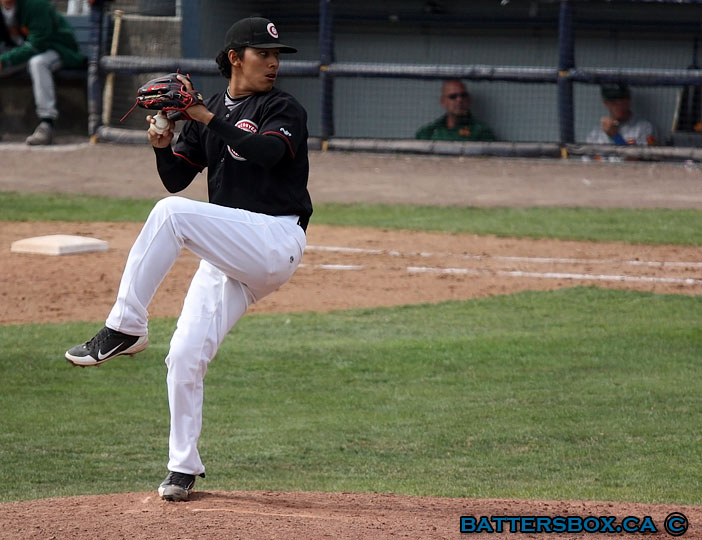
30. Javier Avendano | RHP
| Year | Age | Level | G | GS | IP | H/9 | HR/9 | BB/9 | K/9 | ERA |
| 2009* |
18 |
RK | 5 |
1 |
13.0 |
6.9 |
1.4 |
4.2 |
9.7 |
2.08 |
| 2010* |
19 |
RK | 10 |
8 |
40.0 |
5.9 |
0.2 |
3.2 |
11.7 |
1.35 |
| 2010* |
19 |
A- |
1 |
1 |
4.0 |
6.8 | 0.0 |
9.0 |
9.0 |
4.50 |
| 2011* |
20 |
A- |
9 |
1 |
14.1 |
6.9 |
0.6 |
5.0 |
11.9 |
3.14 |
| 2012 |
21 |
A | 0 |
5.9 |
0.0 |
5.3 |
11.6 |
1.48 | ||
| 2012 |
21 |
A- | 14 |
6.1 |
0.4 |
2.9 |
10.5 |
1.27 |
* - with Cardinals organization
A non-drafted free agent who signed with St. Louis for a $100,000 bonus in 2007, Avendano was taken by the Blue Jays in the minor league Rule 5 draft last winter. If 2012 is any indication, this could be a shrewd pick-up for Toronto. Coming off shoulder surgery that cut short his 2011 season, Avendano pitched out of the bullpen for the Lansing Lugnuts and struck out nearly 30 percent of the hitters he faced while notching a pair of saves. His only real issue was handing out too many free passes, just over five per nine innings, but he was resourceful enough to keep most runners from scoring as evidenced by an 80 percent strand rate.
In an effort to stretch him out, Avendano was sent out west to Vancouver where he teamed up with fellow righty Taylor Cole to form a solid 1-1A punch in the Canadians starting rotation. He shared the Northwest League lead in wins with eight, led the circuit in strikeouts with 91 and finished second to Cole in earned run average. He continued to strike out just over 30 percent of the batters he faced, cut his walk rate by over two batters and finished with a WHIP of one.
Avendano continued to appease the baseball gods with a strand rate of 88 percent and a BABIP of .275. With most studies showing that pitchers on average strand runners in the 70-72 percent rate, that may be a tad much to sustain for Avendano going forward. His method of treating every hitter like a cleanup hitter and pretending the score is 0-0 worked wonders for him in Vancouver. As he told the Vancouver Province about facing opposing hitters, “ I don’t care if they’re small, big, fat, skinny. If they are here, if they have signed a contract, they can hit.” Avendano has also made progress speaking English after not being able to speak a word of it two years ago.
Avendano’s repertoire features a fastball in the 88-90 miles per hour range but went as high as 92. He also threw a curveball in the mid 70s, a changeup in the low 80s and the odd sinker.
Avendano racked up plenty of hardware in 2012. He won the Northwest League pitcher of the week award three times, a Northwest League championship ring and the R. Howard Webster Award as the Jays top minor leaguer in Vancouver. Slated to pitch in Venezuela this winter, Avendano may begin next season back in Lansing or he may be challenged with a promotion to Dunedin. He will turn 23 on September 6.
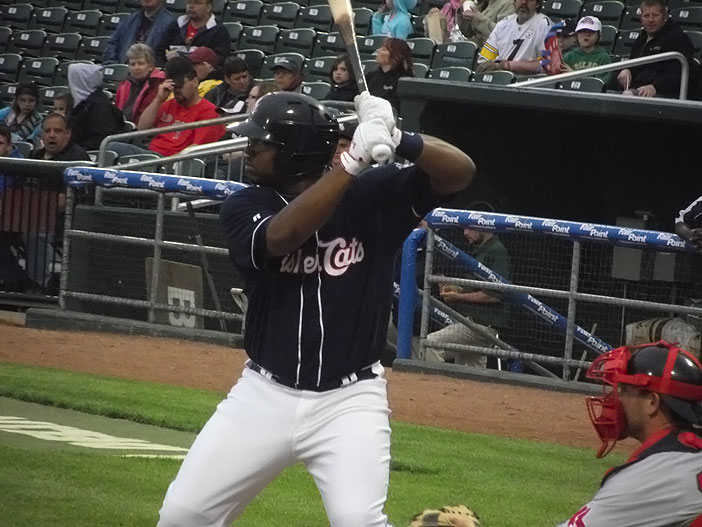
29. Mike McDade | 1B
| Year | Age | Level | AB | 2B | 3B | HR | BB | K | SB | CS | AVG | OBP | SLG |
| 2008 |
19 |
A- |
191 |
8 |
1 |
3 |
22 |
53 |
1 |
0 |
.257 |
.333 |
.287 |
| 2008 |
19 |
A |
216 |
13 |
0 |
2 |
11 |
63 |
0 |
0 |
.194 |
.236 |
.282 |
| 2009 |
20 |
A |
408 |
27 |
1 |
16 |
32 |
109 |
0 |
0 |
.277 |
.336 |
.466 |
| 2010 |
21 |
A+ |
480 |
22 |
1 |
21 |
27 |
141 |
2 |
0 |
.267 |
.315 |
.448 |
| 2011 |
22 |
AA |
484 |
37 |
0 |
16 |
28 |
104 |
0 |
1 |
.281 |
.328 |
.457 |
| 2012 |
23 |
AA |
378 |
16 |
0 |
15 |
43 |
85 |
1 |
0 |
.275 |
.354 |
.437 |
| 2012 |
23 |
AAA |
71 |
3 |
1 |
2 |
7 |
11 |
0 |
0 |
.338 |
.392 |
.493 |
2012 was not a stand-out season for McDade but don't forget he is a 23 year old in AAA. McDade returned to AA for most of the season, he was blocked in AAA by David Cooper until August. McDade put up similar hitting numbers in AA in 2011 as he did in 2012, except that he increased his walk rate. McDade walked 28 times in 2011 and 50 times in 2012. First base in the major leagues has a very high bar for performance but McDade is a switch hitting first baseman which has some value. 2013 should be a big year for McDade in Buffalo, he will be 24, he will be in a "normal" hitting environment, and it will be his big chance to stake a major league claim.
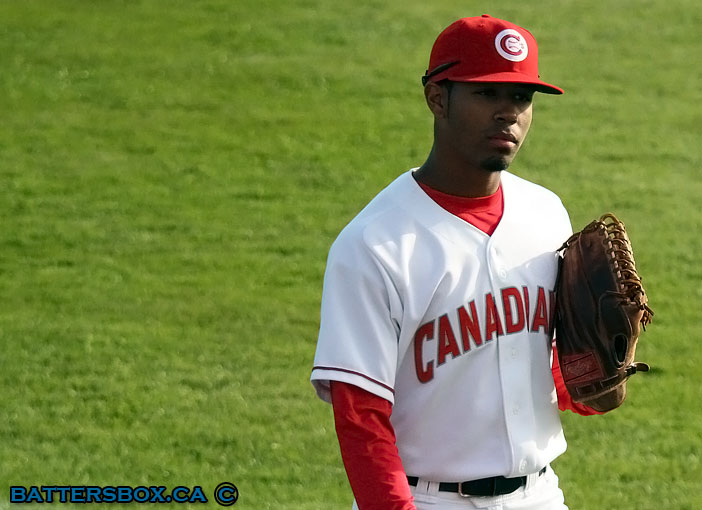
28. Dalton Pompey | OF
| Year | Age | Level | AB | 2B | 3B | HR | BB | K | SB | CS | AVG | OBP | SLG |
| 2010 |
17 |
Rk |
47 |
0 |
0 |
2 |
3 |
10 |
4 |
1 |
.191 |
.255 |
.319 |
| 2011 |
18 |
Rk |
68 |
3 |
0 |
1 |
14 |
23 |
4 |
1 |
.191 |
.353 |
.279 |
| 2011 |
18 |
Rk |
158 |
7 |
2 |
4 |
24 |
35 |
19 |
0 |
.259 |
.361 |
.405 |
| 2012 |
19 |
Rk |
14 |
1 |
1 |
0 |
0 |
2 |
1 |
0 | .357 |
.357 |
.571 |
| 2012 |
19 |
A- |
44 |
3 |
1 |
0 |
9 |
7 |
3 |
0 |
.294 |
.442 |
.441 |
| 2012 |
19 |
A |
24 |
0 |
1 |
0 |
1 |
5 |
1 |
1 |
.227 |
.261 |
.318 |
Pompey, a Canadian gem unearthed by scout Jamie Lehman, has three pro seasons under his belt but is still just 19 years old. Unfortunately, he's struggled to stay healthy during his career and appeared in just 20 games in 2012 due to a broken hamate bone. The organization's handling of him, though, speaks volumes as he still played at three different levels - the Appalachian, Northwest and Midwest leagues. Despite his youth and lack of experience, Pompey shows a promising offensive game as a switch-hitter with a solid eye, raw power potential and speed. He should spend the 2013 season back in the Midwest League and will simply look to stay healthy and show some consistency. 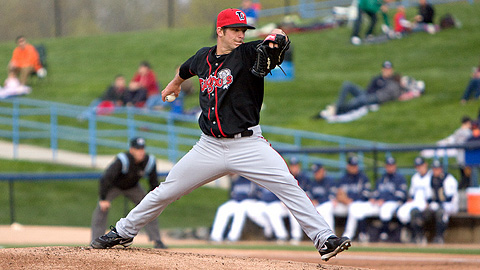
27. Marcus Walden | RHP
| Year | Age | Level | G | GS | IP | H/9 | HR/9 | BB/9 | K/9 | ERA |
| 2008 |
19 |
A- |
14 | 11 | 60.0 |
10.5 |
0.6 |
3.0 |
7.6 |
4.80 |
| 2009 |
20 |
A+ |
4 | 4 | 16.2 |
16.2 |
0.5 |
5.4 |
4.3 |
8.64 |
| 2011 |
22 |
A |
28 |
13 |
100.0 |
8.1 |
0.1 |
2.5 |
4.9 |
3.24 |
| 2012 |
23 |
A |
14 |
14 |
66.2 |
7.3 |
0.5 |
4.0 |
5.4 |
3.10 |
| 2012 |
23 |
A+ |
13 |
12 |
72.2 |
7.2 |
0.0 |
2.2 |
5.2 |
2.85 |
Some players towards the bottom of the Top 30 list are very raw with a lot of potential and others lack projectability, but have succeeded as a professional and have the potential to become role players or supplementary pieces. Marcus Walden is one of the latter. No relation to Anaheim’s relief pitcher Jordan Walden, Marcus Walden was born on September 13, 1988 in Fresno, California. He was a 9th-round draft pick in the 2007 draft from Fresno City College, but his professional career has been interrupted as he missed nearly two years with injuries.
The 5’10” 185-pound right-hander had solid, but unspectacular, seasons for the Gulf Coast Blue Jays in 2007 and the Auburn Doubledays in 2008. He got off to a rocky start for Dunedin in 2009 and then after making four starts he suffered an injury that ended his season. Walden subsequently underwent Tommy John surgery and nerve transposition surgery. He wasn’t able to return to game action until 2011.
Not surprisingly, Walden split his first season back in action between the bullpen and the starting rotation. With the Lansing Lugnuts, Walden twirled 100 innings. He put up a 3.24 ERA, allowing 90 hits and 28 bases on balls with 54 strikeouts. Walden returned to Lansing to begin the 2012 season and transitioned back into being a permanent starter, as he was prior to his injury. With the Lugnuts, Lansing pitched 66.2 innings, walking 30 and striking out 40 with a 3.10 ERA. He earned a promotion to Dunedin for the second half of the season and posted even better numbers, with a 2.85 ERA over 72.2 innings. Walden only walked 18 and struck out 42 and didn’t allow a home run.
It’s very unlikely that Walden’s flashy ERAs will continue if he doesn’t improve upon the peripherals he posted during the first half of the season. Since returning from his injury, Walden’s strikeout rate hovers around the low 5.0’s. A low strikeout rate in A-ball is not a positive sign and Walden has a tiny margin for error in terms of allowing it to fall any further as he progresses up the organizational ladder. A low strikeout combined with control problems are even worse and in the first part of this season, Walden posted a 4.0 BB/9 and a 5.4 K/9 rate. However, he nearly cut his walk rate in half during his time with Dunedin, posting a 2.2 BB/9 rate and a 5.2 K/9 rate in the FSL. Walden does control the running game quite well and doesn’t allow many stolen bases.
Walden doesn’t have eye-popping stuff and, outside of his ERA, his numbers aren’t striking. However, he has a good head for pitching and has persevered through a couple of nasty injuries. If Walden keeps his walk rate relatively low and his strikeout numbers don’t fall any further, he has a chance to emerge as a back-end rotation member or middle reliever. He should begin next year with New Hampshire, or move there relatively quickly, but Double-A will be a big test to see how Walden’s stuff plays against more advanced competition.
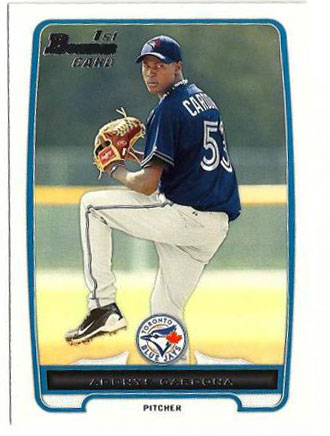
26. Adonys Cardona | RHP
| Year | Age | Level | G | GS | IP | H/9 | HR/9 | BB/9 | K/9 | ERA |
| 2011 |
17 | Rk | 10 | 7 | 31.2 | 8.80 | 0.57 | 3.40 | 9.95 | 4.55 |
| 2012 |
18 | Rk | 8 |
2 |
15.2 | 8.60 | 0.58 | 5.74 | 11.49 | 6.32 |
The Jays were cautious with their 2010 bonus baby by holding him to just eight appearances in the Gulf Coast League. Part of this was necessitated by an injury which kept Cardona in Extended Spring Training and then finished his season at the end of July. When he was on the mound Cardona performed as expected. He struck out more than a batter an inning and showed signs of wildness. All normal for a big-armed 18 year-old.
However, some scouts seem to be souring a bit on Cardona's future, perhaps due in part to his injury. While he was still flashing a mid 90s fastball, some reports suggested he may be better suited in the bullpen.
2013 will be an important year for Cardona. He'll turn 19 in January and, if healthy, will likely be expected to increase his workload a fair bit. He still has the velocity and the size that scouts dream of so a solid season could push him into elite prospect territory.
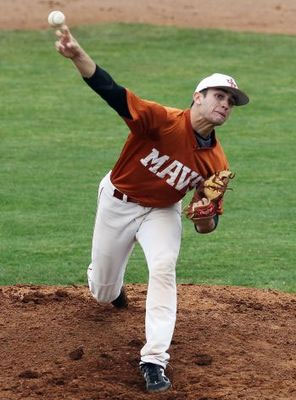
25. Tyler Gonzalez | RHP
| Year | Age | Level | G | GS | IP | H/9 | HR/9 | BB/9 | K/9 | ERA |
| 2012 |
19 |
Rk |
9 |
3 |
15.0 |
12.00 |
0.60 |
2.40 |
4.20 |
8.40 |
The last of Toronto's three 2012 first round supplemental round draft picks, Gonzales signed out of a Texas high school, forgoing a scholarship to the University of Texas. The right-hander has dynamite stuff that includes two potentially-plus pitches in his slider and fastball, which can touch 95-96 mph. His changeup is in the nascent stage but it may not be necessary; Gonzales' future is probably in the bullpen. He has an extremely violent delivery that will likely keep his command numbers from being anything more than fringe-average. His frame is also on the slender side so his body may not hold up to starting unless the organization makes some adjustments to try and smooth out his delivery. Gonzales, 19, got off to a rough start to his pro career with 12 runs allowed in his first three appearances, spanning 1.2 innings. He then allowed just two runs in his next six appearances (13.1 innings). He'll likely open 2013 in extended spring training before moving up to Bluefield.
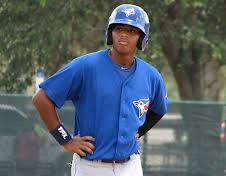
24. Dawel Lugo,| SS
| Year | Age | Level | AB | 2B | 3B | HR | BB | K | SB | CS | AVG | OBP | SLG |
| 2012 |
17 |
Rk |
170 |
2 |
5 |
2 |
7 |
25 |
5 |
1 |
.224 |
.275 |
.329 |
Lugo was born in December 1994, he played in the GCL this year as a 17 year old. Lugo's stats this season don't mean much; as a 17 year old he is getting used to professional baseball and to living in the US. Lugo would be in grade 12 now if he was living in the US.
Lugo signed in 2011 for $1.3M. At that time Baseball America projected Lugo to eventually end up at 3B. However after his first season in the GCL BA said there was a good chance Lugo could stay at short. Lugo has great hand eye coordination but he does need to be come more selective at the plate. Lugo will go back to extended spring training in 2012 but will hope to make it to Bluefield in June.
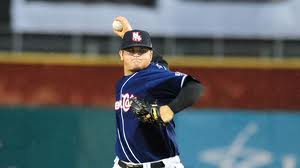
23. Chad Jenkins | RHP
| Year | Age | Level | G | GS | IP | H/9 | HR/9 | BB/9 | K/9 | ERA |
| 2009 |
22 |
DNP |
||||||||
| 2010 |
23 |
A |
13 |
13 |
79.1 |
9.98 |
0.5 |
1.47 |
7.26 |
3.63 |
| 2010 |
23 |
A+ |
13 |
13 |
62.1 |
10.5 |
0.9 |
2.6 |
6.0 |
4.33 |
| 2011 |
24 |
A+ |
11 |
11 |
67.1 |
9.49 |
0.4 |
1.87 |
5.88 |
3.07 |
| 2011 |
24 |
AA |
16 |
16 |
100.1 |
8.3 |
0.7 |
2.42 |
6.64 |
4.13 |
| 2012 |
25 |
AA |
20 |
20 |
114.1 |
11.41 |
1.34 |
2.44 |
4.49 |
4.96 |
| 2012 |
25 |
MLB |
13 |
3 |
32.0 |
9.0 |
1.41 |
3.09 |
4.50 |
4.50 |
The former No. 1 draft pick (from the J.P. Ricciardi era) entered 2012 teetering precariously on the line between legit prospect and bust. The beginning of his season was far from encouraging as he returned to double-A and posted worst numbers than during half a season at the same level in '11. Injuries, though, gave Jenkins a chance to prove himself at the big league level and he responded with better than expected results. Pitching mostly out of the bullpen, and almost exclusively in low-leverage situations, the right-hander showed average control but lacked a reliable out pitch and was susceptible to the long ball. Despite his pedigree and decent debut, Jenkins' ceiling is probably that of a No. 4 starter or middle/long reliever. The 24-year-old's repertoire includes an 87-91 mph fastball that can add a couple ticks when he comes out of the bullpen, as well as an effective slider and decent changeup.
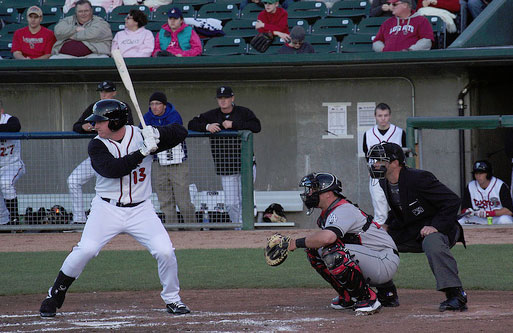
22. Chris Hawkins | OF
| Year | Age | Level | AB | 2B | 3B | HR | BB | K | SB | CS | AVG | OBP | SLG |
| 2010 |
18 |
RK |
157 |
9 |
3 |
0 |
15 |
38 |
8 |
3 |
.255 |
.324 |
.350 |
| 2011 |
19 |
A+ |
4 |
0 |
0 |
0 |
0 |
2 |
0 |
0 |
.000 |
.000 |
.000 |
| 2011 |
19 |
RK+ |
242 |
15 |
6 |
5 |
22 |
46 |
14 |
4 |
.318 |
.375 |
.492 |
| 2012 |
20 |
A |
491 |
17 |
4 |
2 |
46 |
78 |
11 |
0 |
.269 |
.331 |
.332 |
The 2010 third-round pick out of North Gwinnett High School near Atlanta who spurned Tennessee for a $350,000 bonus had his share of ups and downs in 2012. The highlights included a berth in the Midwest League All-Star game with the Lansing Lugnuts and batting averages of well over .300 in three separate months, including .327 marks in May and July. Unfortunately, Hawkins endured an ugly June in which he hit just .160 and fought to stay above .200 for August and September. The one constant for Hawkins was a lack of thunder in his bat as his isolated power was just over 60 cents with the Lugnuts, That was a sharp drop from the .174 mark he posted in Bluefield last year, which resulted in Hawkins garnering a R. Howard Webster award and a #11 ranking of the Appalachian League's Top Prospects by Baseball America. A left-handed hitter, Hawkins more than held his own against southpaws by hitting .303 in 99 at-bats. He was also perfect on the basepaths, going 11-for-11.
As noted by many scouts and observers, the 6-2, 195 pound Hawkins has a funky swing that includes an arm bar but he compensates with quick wrists and is said to have at least average power. Some scouts initially labelled him as a poor man’s Colby Rasmus after his shift from the left side of the infield to the outfield. However, Hawkins has been limited to left field because of a lack of arm strength. He is also continuing to learn the finer points of playing in the green, such as getting good jumps and better reads on fly balls. A fan of Braves catcher Brian McCann, Hawkins has worked on his hitting with McCann’s father.
Hawkins will probably be back in Lansing in 2013 but a hot start could land him in Dunedin later in the season. He will turn 22 August 17.
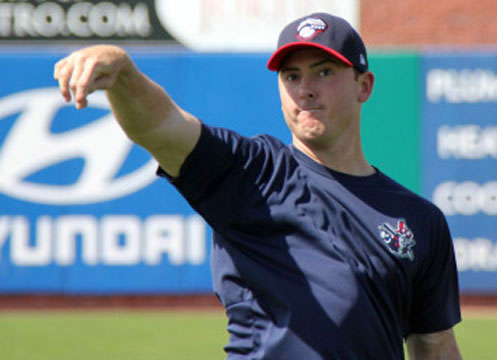
21. Sam Dyson | RHP
| Year | Age | Level | G | GS | IP | H/9 | HR/9 | BB/9 | K/9 | ERA |
| 2012 | 24 | A+ |
6 |
6 |
28.2 |
10.99 |
0.31 | 1.57 | 5.02 | 3.17 |
| 2012 | 24 | AA |
33 |
0 |
45.1 |
7.54 |
0.40 | 2.98 | 4.37 | 4.06 |
| 2012 | 24 | MLB |
2 |
0 |
0.2 |
27.00 |
54.00 | 27.00 | 13.50 | 40.50 |
After opening the year in the starting rotation, Dyson slid into the bullpen upon his promotion to double-A and that will no doubt be his future role in the big leagues. The right-hander's delivery, which includes a near sidearm slot, makes him naturally susceptible to good left-handed hitters because it limits the effectiveness of his breaking ball. As well, he produces low strikeout rates and tends to pitch to contact with tons of ground balls. Both those facts limit the pitcher's ceiling and suggest he'll top out as a middle reliever, or possibly an eighth guy. Dyson got hit around a bit during a two-game stint in the majors and then struggled upon his return to the minors, perhaps suffering from a bit of a confidence bruise. His repertoire includes a 90-95 mph fastball that he throws 80-90% of the time, as well as a curveball and changeup. As a ground-ball machine, Dyson needs good infield defense behind him, something he didn't always have in 2012.




